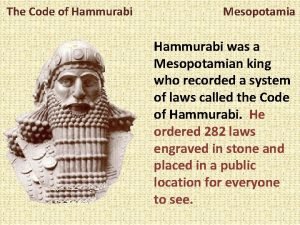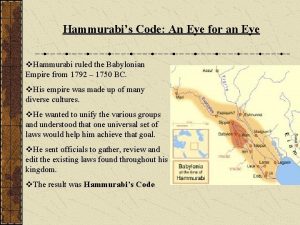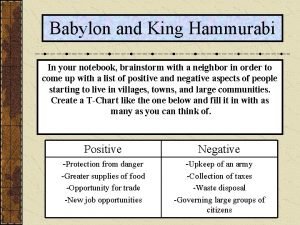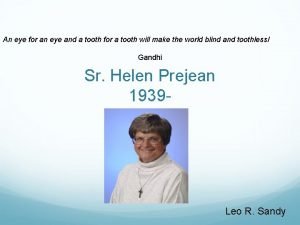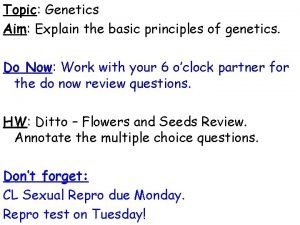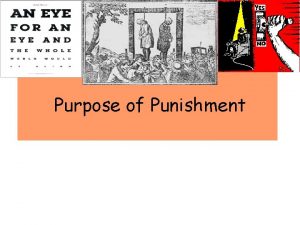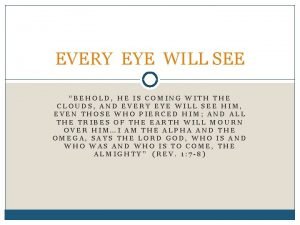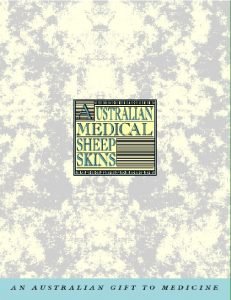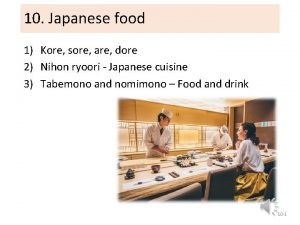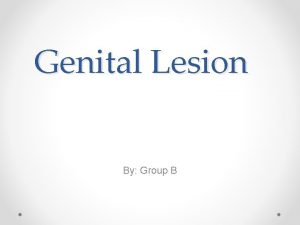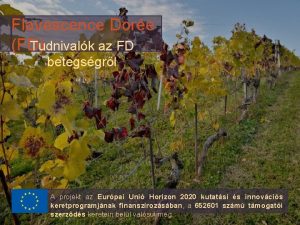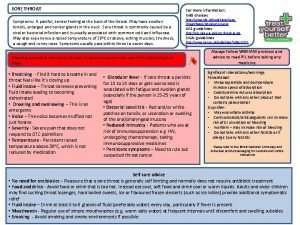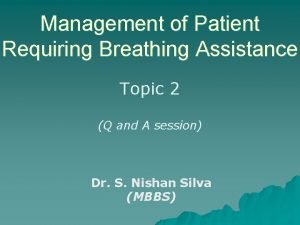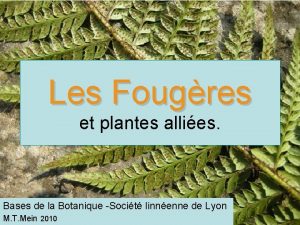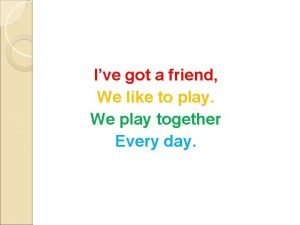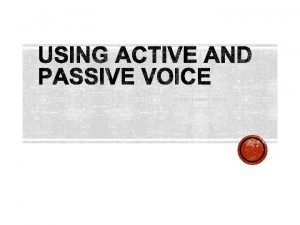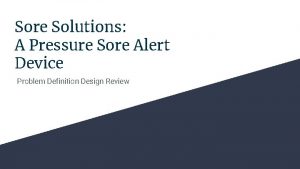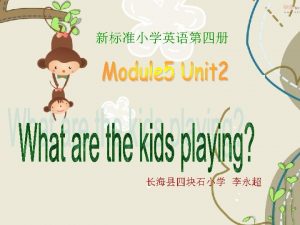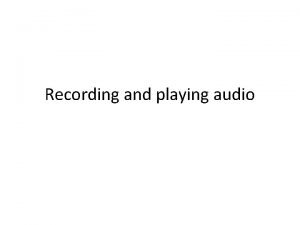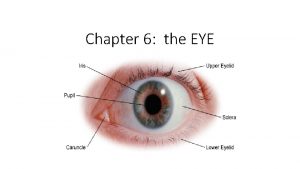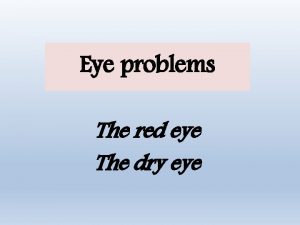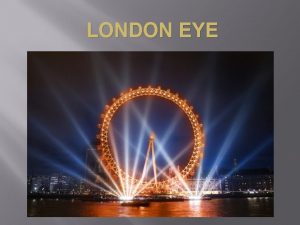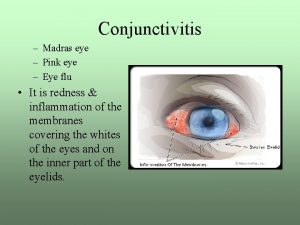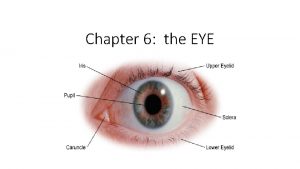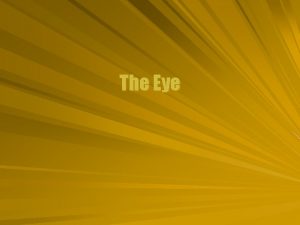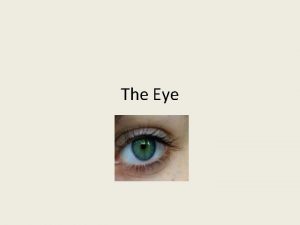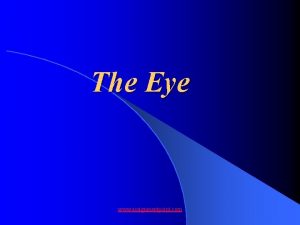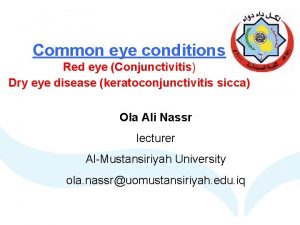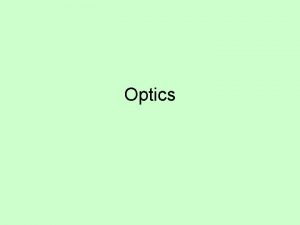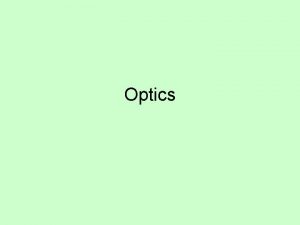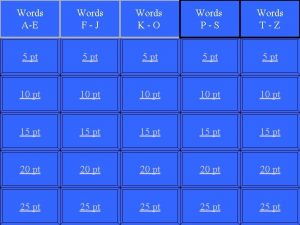Playing with Words Poetry Play Eye Sore I
























- Slides: 24

Playing with Words Poetry Play

Eye Sore I saw a building soar into the sky making the sky’s eye sore. © Roger Mc. Gough

Language can stretch! The poet and storyteller Michael Rosen has described language as putty because it is so stretchy. You can - squash it squeeze it stretch it shape it and make it do anything you want!

Headline Play Waugh cry as Aussies blast off Science friction For a whole set of puns on Wayne Rooney’s name, see: http: //news. bbc. co. uk/1/hi/magazine/3836159. stm

Poetry – Language Play n Poetry is language play at its most extreme The only problem with haiku is that you just get started and then © Roger Mc. Gough n You can play with words, images, rhythms, rhymes, sounds. . n . . and even the shape of a poem on the page.

Ampersand © Patrick Winstanley Breezes © Court Smith

Riddles I have holes on the top and bottom. I have holes on my left and on my right. And I have holes in the middle, yet I still hold water. What am I? n A sponge. Take off my skin, I won't cry, but you will. What am I? n An onion

Riddles Who dips, dives swoops out of space, a buzz in his wings and sky on his face now caught in the light, now gone without trace, a sliver of glass, never still in one place

Who’s elusive as pickpocket, lord of the flies; who moves like a rocket, bound for the skies? Who’s catapult, aeroplane, always full-throttle? Sky-diver, Jumping Jack, comet, bluebottle! © Judith Nicholls

Creating images with words Extended noun phrases You can build description and detail by adding more information to the main noun. You can do this in several ways: Ø by adding adjectives before or after the noun Ø by adding a relative clause after the noun (one which begins with that, who, which etc) Ø by adding a non-finite clause after the noun (one which uses the –ing or –ed form of the verb) Ø By adding a prepositional phrase after the noun (one which starts with a preposition e. g. at, on, by, under) The insolent teenager, who stood sulking by the teacher’s desk. . .

A family celebration Ancient Uncle Henry in his favourite armchair, snoring loudly through the Queen’s speech. . . My little brother dressed in his new Spiderman outfit, trying to fly down the stairs. . . Mum curled up on the sofa, picking the chocs with purple wrappers out of the Quality Street tin, and thinking no-one’s noticed. . Our scraggy tabby under the table, fighting with a fallen turkey bone. . . An unwrapped present by the Christmas tree, hidden in a tangle of tinsel. . . Snow swirling softly past the window: another family Christmas coming to an end. . .

Kennings n The word kenning comes from Old Norse: kenna – to know n We have a relic of this in English especially in the North – ‘Do you ken John Peel? ’ n The kenning is a naming device – a way of creating new nouns n It always involves at least two words, usually two nouns n So a kenning is a compound noun

n The kenning was used over a thousand years ago in Anglo-Saxon and Norse poetry to create fresh, new descriptions of well-known things n n Here are some examples: ¨ banhus (bone house) for body, ¨ hron rad (whale road) for sea, ¨ helmberend (helmet carrier) for warrior. These kennings are metaphors: they name something by comparing the original object with something different. Can you see this?

These are all kennings found in Viking or Anglo-Saxon poetry, and in each case the invented kenning is more descriptive than the every day noun. Axe Battle Wolf Dew Sweat Corpse Death Eyes Fire Wind blood-ember spear-din bloodslaughter bloodbattle bloodwound raven harvest sleep of the sword brow-stars bane of wood tree-breaker n Which kenning do you think is most effective and why? n Can you see the different ways in which two nouns have been put together to form a compound noun?

Everyday Kennings n We have lots of modern kennings, but they are now so commonplace that they have lost their descriptive power and have become single word nouns. Here a few: beachcomber lawnmower dishwasher toothbrush n Can you think of any others?

Sound and Layout n One thing that poetry can do, which prose can’t, is play with where a line of poetry ends. Our first realisation that a poem is usually because it is laid out differently on the page. n Poets can also play with line length to give emphasis to different words and images. What comes first and last in a line tends to be more emphatic than everything in between; a word or phrase in a line of its own receives particular emphasis.

Playing with Line Length Look at these two extracts from poems you have already read and speculate why the poets chose to lay their lines out in this way Dear Uncle Bent double, like old beggars under sacks, The soap is Knock-kneed, coughing like hags, we cursed through sludge, terrific Till on the haunting flares we turned our backs So And towards our distant rest began to trudge. useful

Playing with Line Endings n Poets can also play with making one line of poetry run into the next: this is called enjambement or run-on lines. n Enjambement helps to keep together information which is closely related: in other words, it helps the sense of a line to carry through into the next line: Striding forward along the rails Thro' southern uplands with northern mails. n Enjambement also helps to alter the sound of poetry in your head or when read aloud by disrupting the rather dull habit of pausing at the end of each line. The run-on lines carry the voice straight from one line to the next: If in some smothering dreams you too could pace Behind the wagon that we flung him in,

Playing with Line Breaks n Instead of deciding to run one line into the next, a poet can also decide to stop the line in the middle with a full stop, dash or colon which create a break in the line. This is called caesura or a mid-line break. n Just as enjambement alters the sound of poetry by running two lines together, caesura alters the sound of a poem by creating an unexpected stop. n The unexpected stop mid-line, usually creates emphasis by drawing attention to something: it could signal an increase in tension, emphasise an image, or signal the importance of what follows. Think about what the effect of the causura is in the examples on the next slide.

What’s the Effect? To be, or not to be: that is the question. Gas! Quick, boys! – An ecstasy of fumbling, He sat in a wheeled chair, waiting for dark, And shivered in his ghastly suit of grey, Legless, sewn short at elbow. Through the park Voices of boys rang saddening like a hymn,

Sentence Patterns Searching my face, I see only tears. My heart reaches for love. In the silver lake, the moon flickers. Then darkness. Some patterns that are easy to use in your writing for variety n Long sentences followed by short sentences n Short sentences followed by long sentences n Sentences without a verb n Several short sentences following each other n A one word sentence n Repeated sentences There are may other sentence patterns – look for them in the texts you read!

Sentence Starts The family cat was there in front of him, looming large like a monster in the headlights. And there before him, looming large like a monster in the headlights, was the family cat. [and look what punctuation can do !] And there before him, looming large like a monster in the headlights, was - the family cat! Like a monster in the headlights, the family cat loomed before him. Vary how you start your sentences to alter which information the reader receives first or last; or to vary the rhythm of the text.

Playing with Sentences There is nothing wrong with using ‘plain, ordinary’ sentences – and sometimes they are just what is needed. But there are two good reasons to think about varying your sentences, not just for poetry, but for all writing. 1. If you use only ordinary sentences, which are all of a similar length and all start with a subject, it makes the rhythm of your writing very dull and flat, like talking in a monotone. 2. If you use only ordinary sentences, it is harder to influence your reader: by varying what information comes first, or is delayed until the end of a sentence, you can create excitement, emphasis, or suspense. So start playing with designing your sentences!

Playing with Words! n Noun phrases for description – creating strong images and providing detail n Vocabulary – choosing exactly the right word n Kennings – inventing kennings to describe something in an imaginative way n Punctuation – using punctuation to mark meanings or emphasise ideas n Repetition – using repeated words or sentence patterns for emphasis or effect n Alliteration – repeating consonant sounds to connect related ideas or images n Enjambement – linking ideas across lines by running them on n Caesura – stopping the reader mid-line to give impact or emphasise what follows n Rhyme and rhythm – matching sound and meaning n Line length – using line length to play with meanings n Sentence length – varying sentence length to create different rhythms and pace n Sentence variety – starting sentences differently to emphasise meanings n Personification – giving life and thought to an object by presenting it as a person
 Eye for an eye code
Eye for an eye code Birds eye view and worm's eye view
Birds eye view and worm's eye view Hammurabi code eye for an eye
Hammurabi code eye for an eye Pdf
Pdf Hammurabi code an eye for an eye
Hammurabi code an eye for an eye An eye for an eye a tooth for a tooth sister act
An eye for an eye a tooth for a tooth sister act Blue eyes dominant or recessive
Blue eyes dominant or recessive An eye for an eye meaning
An eye for an eye meaning Behold he is coming
Behold he is coming Ischial pressure ulcer location
Ischial pressure ulcer location Braden score meaning
Braden score meaning Sore nipples
Sore nipples Braden scale for predicting pressure sore risk
Braden scale for predicting pressure sore risk Kore sore are dore
Kore sore are dore Std called the drip
Std called the drip Sima feels fine but she has a sore throat
Sima feels fine but she has a sore throat Penile sore
Penile sore Kore sore are dore
Kore sore are dore Penis small
Penis small Wwham protocol
Wwham protocol ütube
ütube Indusie
Indusie Breast tenderness early pregnancy
Breast tenderness early pregnancy I've got a friend we like to play we play together
I've got a friend we like to play we play together Play random play basketball
Play random play basketball
